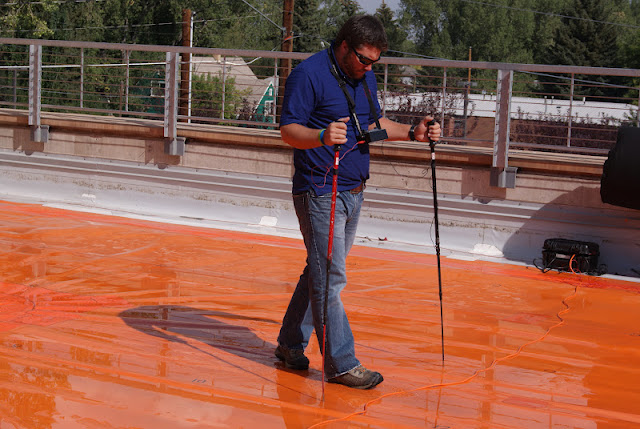As you may have seen, the Berry Prairie is undergoing a bit
of a face lift. Literally! The entire surface of the Prairie has been removed. With
approximately 4,300 individual plants and 62 species to account for (not to
mention the tons of substrate) how do we make the necessary repairs and
maximize the potential for the Prairie to return to the beautiful native
landscape we have grown to love? It’s ‘easy’…Methodically, step by step.
The Fun Part:
With the original design plans in hand, we began by dividing the
Prairie into 10 sections and assigning each section a plastic marker color with a
corresponding tag. Kyle gave each species a number and with the help of his
advisor, Dr. Greg Brown, and the Berry Center’s summer gardener, Joseph, he walked the roof
identifying and tagging plants with their designated color and number. Over
three sunny days each pant was given a new color and number coordinated name
tag.
 |
| All 4300 plants were labeled prior to transplanting |
The Hard Part:
Each plant, some very small and delicate, had to be removed,
potted and transported to the holding area. Fortunately for us, we had an
awesome crew from Highland Landscaping that understood the sensitive nature of
the plants and the project.
 |
| Plants being systematically transplanted by the Highland Landscaping crew |
In just over 20 hours all plants had been removed
and transported, arranged by section and settled into their new home at the
golf course. Smiling up at the sun with a fresh drink of water, the first part
of their tumultuous trip complete, the plants anxiously await their return to
the Berry Prairie.
 |
| All 4300 plants are at the Golf Course for temporary storage, where they are under an irrigation regime. |
What to do with the ‘dirt’:
Removing the plants was relatively easy. No new age
technology required just shovels and buckets, sore backs and sweat. Then what
do we do with the remaining 3,000 plus square feet of substrate? Shovels and
buckets…No Way! We get a Badger!
 |
| Large vacuum truck to remove the "dirt" from the green roof |
The Badger truck is an impressively large vacuum. According
to its operator, it generates more vacuum power then an average tornado and can
pick up a 100lb boulder at the end of a 400ft stretch of hose. There is more to
it than just the awesome power of the Badger, the vacuum technology allowed us
to remove the substrate in layers. First we removed the planting material and
then the underlying gravel bedding. Removing the substrate in layers allows us
to reuse the material saving valuable time and money. Once the truck was full the substrate was
transported to the golf course where it awaits with the plants to return to the
roof.
 |
| The process of removing the substrate involves hours of vacuuming |
Written by Kyle Bolenbaugh, MS candidate, University of Wyoming



































